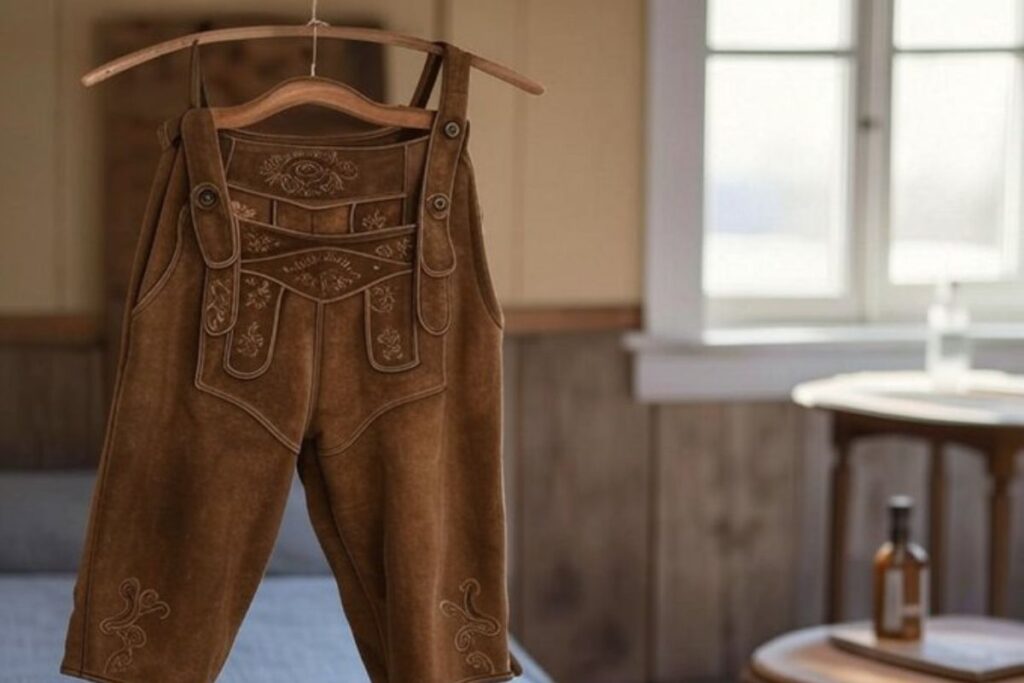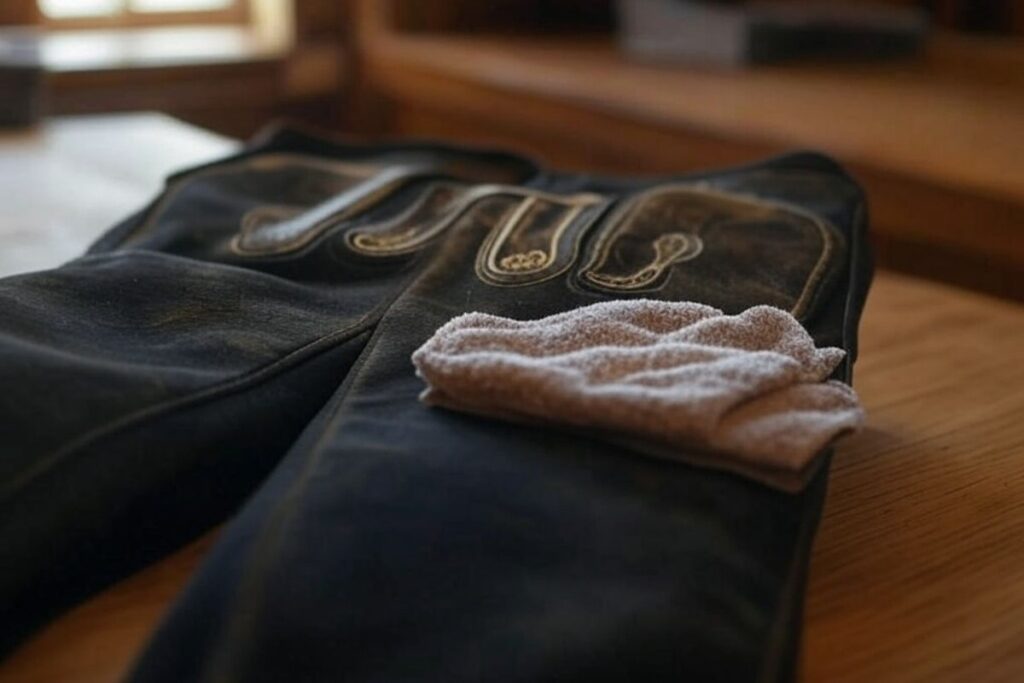How to Wash Lederhosen? Expert Leather Care & Clean Tips

How to wash lederhosen?
Lederhosen, traditionally made from high-quality leather such as goat, deer, or cowhide, require specialized care to maintain their durability and appearance. Unlike regular fabric clothing, these iconic Bavarian garments cannot be tossed into a washing machine. Proper cleaning methods ensure they remain supple, fresh, and long-lasting.
In this guide, we’ll explore how to clean Lederhosen correctly, avoid common mistakes, and maintain them for years to come.
What Are Lederhosen Made From
Here are the steps to clean lederhosen
Spot Cleaning for Minor Stains
For minor stains, spot cleaning is the most effective way to maintain your Lederhosen’s natural texture and durability without exposing it to excessive water or harsh chemicals. By using gentle cleaning techniques, you can remove dirt, sweat marks, and small spills while preserving the leather’s quality. Follow these expert-approved steps to ensure your Lederhosen stays in top condition.

Use a Damp Cloth
Begin by gently blotting the stained area with a soft, lint-free cloth dampened with lukewarm water. The moisture helps lift dirt and minor stains without over-saturating the leather, which could lead to stiffness or cracking. Avoid using hot or cold water, as extreme temperatures can weaken the leather fibers. Always dab the stain gently instead of rubbing, as friction can push the stain deeper into the material.
Apply a Mild Soap Solution
For tougher stains, prepare a pH-neutral soap solution by mixing a few drops of castile soap or saddle soap with lukewarm water. Using a microfiber cloth, apply the solution in small circular motions to break down the stain without damaging the natural grain of the leather. Avoid using harsh detergents or household cleaners, as these can strip the leather of its natural oils, causing it to dry out and crack over time.
Use a Soft Brush for Tough Stains
If the stain persists, a soft-bristled brush (such as a suede brush or an old toothbrush) can be used to gently lift dirt from the pores of the leather. Make sure to use light pressure and brush in the direction of the grain to avoid causing abrasions. This technique is particularly effective for mud, dried sweat stains, or dust buildup, as it dislodges particles without damaging the leather’s surface.
Avoid Excessive Scrubbing
Lederhosen are made from delicate, natural leather, which can be easily damaged if scrubbed too hard. Excessive pressure can cause discoloration, surface roughness, or even permanent scuff marks. Instead of forcefully scrubbing, repeat the cleaning process multiple times if necessary. Patience is key when dealing with leather—rushing the process can lead to irreversible damage.
Allow to Air Dry Naturally
After spot cleaning, it’s essential to let the Lederhosen air dry at room temperature. Place them in a well-ventilated area, away from direct sunlight, radiators, or hairdryers, as excessive heat can cause leather to shrink, harden, or develop cracks. Hanging them on a padded hanger allows even airflow, preventing moisture buildup and unwanted creases. If needed, you can use a leather conditioner after drying to restore the material’s natural suppleness.

Pro Tip: For oil-based stains, sprinkle cornstarch or talcum powder over the stain, let it absorb overnight, and gently brush it off the next day.
Never Machine Wash Lederhosen
Washing Lederhosen in a machine can lead to shrinkage, brittleness, and irreversible damage. Why is machine washing a bad idea?
How to Make Lederhosen
Leather Shrinks and Warps When Exposed to Excessive Water and Agitation
Leather is a porous, natural material that absorbs water easily. When soaked in excessive water, the fibers swell and contract unevenly, causing the Lederhosen to lose its original shape. Agitation in a washing machine twists and stretches the leather, leading to wrinkles, deformations, and permanent warping. Once leather loses its natural structure, it’s nearly impossible to restore it to its original form.
Detergents Break Down Natural Oils, Making the Material Stiff and Brittle
Leather contains natural oils that keep it soft, flexible, and long-lasting. Machine-washing with detergents strips away these essential oils, leaving the leather dry, stiff, and prone to cracking. Many commercial laundry detergents contain harsh chemicals that further degrade the leather’s texture and suppleness. Without these oils, the material becomes fragile and uncomfortable to wear, significantly reducing its lifespan.
Heat and Spin Cycles Cause Irreversible Damage, Leading to Loss of Elasticity and Texture
Washing machines use high-speed spin cycles and varying water temperatures, which can be extremely damaging to leather. Heat exposure from hot water, tumble drying, or prolonged spinning causes the leather to harden, shrink, and lose its natural elasticity. Once leather becomes brittle and loses its smooth texture, restoration is nearly impossible without professional treatment.
Best Alternative: Instead of machine washing, always opt for gentle spot cleaning or professional leather cleaning services to ensure your Lederhosen remains in pristine condition for years to come.
Lukewarm Water Only – The Right Way to Clean Lederhosen
When it comes to hand-washing Lederhosen, using the right water temperature is crucial to preserving the leather’s texture, flexibility, and durability. Extreme temperatures—either too hot or too cold—can weaken the leather fibers, leading to stiffness, shrinkage, or cracking. To ensure a gentle yet effective clean, follow this expert-recommended technique:
Fill a Basin with Lukewarm Water (Not Hot, Not Cold)
Start by filling a clean basin or sink with lukewarm water—ideally between 85°F to 95°F (29°C to 35°C). This temperature is warm enough to break down dirt and sweat stains without damaging the leather’s natural structure. Avoid using hot water, as it can cause the leather to lose its oils, making it dry and brittle. Similarly, cold water can prevent proper cleaning, making it harder to remove grime and residues.
Use Leather-Safe Soap
Not all soaps are safe for leather. To protect your Lederhosen, choose a pH-balanced leather cleaner such as saddle soap, castile soap, or a specialized leather cleaning solution. These cleaners help remove dirt and stains while preserving the leather’s natural oils. Avoid using harsh detergents, dish soap, or laundry soap, as they can strip the leather of its protective layer, causing it to harden and crack over time.
Gently Wipe the Surface
Instead of scrubbing or submerging the Lederhosen in water, use a soft sponge or microfiber cloth to wipe the surface gently. Work in small circular motions, focusing on areas with visible stains, sweat marks, or dirt buildup. This method ensures that the leather absorbs minimal moisture, preventing oversaturation that could weaken the material.

Rinse Sparingly
Lederhosen should never be soaked or rinsed under running water. Excessive water exposure can cause the leather to become rigid and lose its natural elasticity. Instead, use a damp (not soaking wet) cloth to wipe away any soap residue. This method prevents water from seeping into the leather’s pores, which can lead to warping and uneven drying.
Pat Dry Immediately
After cleaning, take a dry microfiber towel or absorbent cloth and gently pat the Lederhosen to remove excess moisture. Avoid wringing or twisting the leather, as this can stretch or deform its shape. Once the surface feels dry, hang the Lederhosen in a well-ventilated room, away from direct heat or sunlight, to allow it to air dry naturally.
Drying and Conditioning Lederhosen
Once cleaned, proper drying and conditioning are key to maintaining the leather’s longevity. Follow these steps:
- Air Dry Naturally: Lay the Lederhosen flat on a towel and let them air dry at room temperature.
- Avoid Direct Sunlight or Heat Sources: Excessive heat can dry out and crack the leather.
- Use Leather Conditioner: Once fully dry, apply a leather conditioner or mink oil to keep the leather supple and prevent stiffness.
- Reshape While Drying: If needed, gently stretch the Lederhosen to maintain their original shape and fit.
Storage and Long-Term Care
Proper storage and maintenance are essential to keep your Lederhosen in pristine condition for years. Always store them in a cool, dry place, away from direct sunlight and humidity, which can cause fading, mold, or stiffness. Use a padded hanger to maintain their shape, and avoid plastic covers that trap moisture—opt for a breathable fabric garment bag instead. Periodically apply a leather conditioner to keep the material supple and crack-free. For long-term storage, stuff the legs with acid-free tissue paper to prevent creases, and keep cedar blocks or silica gel packs nearby to absorb excess moisture and odors.

Common Lederhosen Cleaning Mistakes to Avoid
Maintaining Lederhosen requires proper care and attention, as using the wrong cleaning methods can damage the leather permanently. Here are some common mistakes to avoid when cleaning and storing your Lederhosen:
Using Harsh Detergents
Many people assume that regular soaps or household detergents are safe for cleaning Lederhosen, but these products often contain strong chemicals that strip away the leather’s natural oils. Without these oils, the material becomes dry, brittle, and prone to cracking over time. Always use a leather-safe cleaner to preserve the Lederhosen’s texture and durability.
Scrubbing Too Hard
Leather is a delicate, porous material, and excessive scrubbing can scratch the surface, remove the natural grain, and create uneven patches. This is especially true for suede Lederhosen, where harsh scrubbing can cause the fibers to become rough and matted. Instead, use gentle circular motions and a soft cloth or suede brush to lift dirt without causing damage.
Machine Washing or Dry Cleaning
Both machine washing and dry cleaning are too harsh for Lederhosen. Washing machines cause agitation and heat exposure, which distorts the leather’s shape. Dry cleaning solutions often contain chemicals that weaken leather fibers, leading to permanent damage. Instead, opt for hand-cleaning methods using lukewarm water and leather-safe products.
Storing in Damp Conditions
Leather is highly susceptible to moisture damage, and storing Lederhosen in damp or humid environments can lead to mold, mildew, and an unpleasant musty smell. To prevent this, always store your Lederhosen in a dry, ventilated space with silica gel packs or cedar blocks to absorb excess moisture. Avoid plastic bags, as they trap humidity, causing the leather to deteriorate over time.
FAQ’s
Can Lederhosen get wet?
Yes, Lederhosen can get wet, but excessive moisture can weaken the leather fibers, cause stiffness, and lead to shrinkage. If they do get wet, pat them dry with a soft towel and allow them to air dry naturally away from heat sources. Once dry, apply a leather conditioner to restore suppleness and prevent cracking.
How to make Lederhosen smell better?
To remove odors, let your Lederhosen air out in a well-ventilated space after each wear. Sprinkling baking soda over the surface overnight can help absorb excess moisture and neutralize smells. For deep odor removal, use a leather-safe deodorizing spray or place cedar blocks nearby to maintain freshness.
How to maintain Lederhosen?
Regular maintenance includes gentle spot cleaning, applying a leather conditioner, and avoiding exposure to direct sunlight, excess moisture, or extreme heat. Always brush off dirt with a soft suede brush and store them in a dry, breathable garment bag to prevent dust buildup.
How to store Lederhosen?
Store Lederhosen in a cool, dry place, preferably on a padded hanger to maintain their shape. Avoid plastic covers, as they trap moisture, leading to mold and mildew. Instead, use a breathable fabric garment bag and add silica gel packs or cedar blocks to absorb humidity and prevent odors.
How to wash suede Lederhosen?
Suede Lederhosen should never be submerged in water. Instead, use a suede brush to remove dirt and a suede eraser for stains. For tougher stains, apply a small amount of white vinegar on a microfiber cloth and gently dab the area. Always allow them to air dry naturally and brush the suede to restore texture.
How to wash deerskin Lederhosen?
Deerskin is a softer, more delicate leather, requiring extra care. Clean it using a damp cloth with lukewarm water and mild saddle soap, avoiding excessive moisture. Gently wipe the surface, then pat dry with a soft towel. Once dry, apply a leather conditioner to keep the material supple and resistant to cracks.

Anna Bauer is a seasoned Bavarian fashion expert, cultural consultant, and heritage stylist with over a decade of hands-on experience in traditional German clothing. Born in Munich, the heart of Bavaria, Anna grew up surrounded by the rich traditions of Trachten fashion. Her passion for cultural attire led her to pursue a degree in Fashion and Textile Design at the prestigious University of the Arts Berlin, where she specialized in European folkwear.
Over the past 12+ years, Anna has collaborated with renowned Trachten designers, styled outfits for Oktoberfest events across Germany, and contributed articles to top fashion and culture magazines across Europe. Her work focuses on preserving the authenticity of Lederhosen and Dirndl wear while helping modern audiences style them with confidence and flair.
As the lead content contributor for German Attire, Anna combines her academic background, professional styling experience, and deep cultural roots to provide readers with valuable insights into traditional German fashion. Her blog posts cover everything from historical origins and styling guides to care tips and festival outfit planning—making her a trusted voice for anyone looking to embrace Bavarian heritage in a stylish, modern way.
